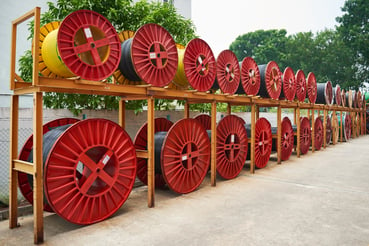Key Principles for Cable Drum Handling and Storage
Keystone Academy
Aug 11, 2020
Cable drums are primarily meant to protect the cables from damage and to store cables properly for use. We have summarized some recommendations below for drum handling and storage as we employ these same methods in our factory and warehouse.
It is important that cable drums are handled and stored correctly to prevent any unwanted impact or damage to the cables. Damaging cable drums due to mishandling could void your warranty with manufacturers if the cables were compromised. So it is important to take precautions.
 Handling Drums
Handling Drums
- Never attempt to move a cable drum by dropping the drum, such as from the transport vehicle. This will potentially damage both the drum and cable. Always use proper lifting equipment, such as cranes or forklifts, when moving drums.
- When hoisting cables, use a spreader bar so the lifting chain does not press against the drum directly; otherwise, it creates unnecessary friction that can weaken the chain or damage the drum.
- When using forklifts, under no circumstances should the forklift forks come in contact with the cables. Lift the drum at 90° to the flanges and ensure the divisions extend past both flanges to make a safe and complete lifting of the drums.
- Drums should only be rolled, where necessary, for short distances and only in a direction that would not loosen the cable in the drum. Else this could cause potential kinking and tangling of the cable.
Storage of Drums
- Drums should be stored on a hard surface with wedges or barriers to prevent the drums from rolling.
- If the storage surface is soft or not flat, e.g. soil, it is important to elevate the drum off the ground to prevent the possibility of subjecting the drums to continually damp conditions that could damage the cable or the drum.
- Avoid storing cable drums lying flat on the side, as this creates unwanted stress on the cable layers at the bottom. Drums should be stored upright.
Uncoiling of Cables
- To uncoil cables, support the drum on a jack stand or the equivalent. When using a stand, always be mindful of pulling the cable from the top, not the bottom, where the cable can scrape against the floor.
- As aforementioned, avoid laying drums flat on the side. By the same token, avoid uncoiling cables from drums that are laid flat, as this could cause unwanted scratches to the cables against the drum flanges during the uncoiling process.
- If a cable length has been cut from the drum, the exposed cable end remaining on the drum should be resealed immediately with a heat-shrinkable end cap to prevent any moisture or water ingress. The drum’s protective covering should also be restored where possible.
We are in the process of updating our guides. For more information, please contact us for further inquiries.
